Coordinators:
Alvaro Jaramillo
John Cant
Mars Muusse
Index ORG
ring projects
PDF's
1cy June
1cy July
1cy Aug
1cy Sept
1cy Oct
1cy Nov
1cy Dec
2cy Jan
2cy Feb
2cy March
2cy April
2cy May
2cy June
2cy July
2cy Aug
2cy Sept
2cy Oct
2cy Nov
2cy Dec
3cy Jan
3cy Feb
3cy March
3cy April
3cy May
3cy June
3cy July
3cy Aug
3cy Sept
3cy Oct
3cy Nov
3cy Dec
4cy / sub-ad Jan
4cy / sub-ad Feb
4cy / sub-ad March
4cy / sub-ad April
4cy / sub-ad May
4cy / sub-ad June
4cy / sub-ad July
4cy / sub-ad Aug
4cy / sub-ad Sept
4cy / sub-ad Oct
4cy / sub-ad Nov
4cy / sub-ad Dec
adult Jan
adult Feb
adult March
adult April
adult May
adult June
adult July
adult Aug
adult Sept
adult Oct
adult Nov
adult Dec |
adult: April
Below you will find a description of Chapter 31 WESTERN GULL Larus occidentalis, as published in one of the best Gull publication: "Gulls of the Americas" by Steve Howell & Jon Dunn.
"we" in the text below refers to the original authors. If any errors occur in this text, please let me know and mail to marsmuusseatgmaildotcom.
PART 1 - summary and distribution
PART 2 - similar species
PART 3 - rarer species (this page below)
PART 4 - Glaucous-winged Gull X Western Gull
Rarer species
Adult Cycle.
Note leg color, slaty gray tone of upperparts, wingtip pattern, and overall structure; in winter, Western Gull typically has a bright yellow to orange-yellow bill that sets it apart from most other gulls in its range. See Great Black-backed Gull and Kelp Gull (differences given under those species). Also see hybrid Glaucous-winged Gull X Western Gull account.
Hybrid Kelp Gull X American Herring Gull. F1 hybrids probably less thickset overall, perhaps with less bulbous-tipped bill; legs yellow to greenish yellow.
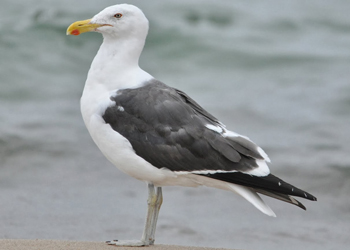 |
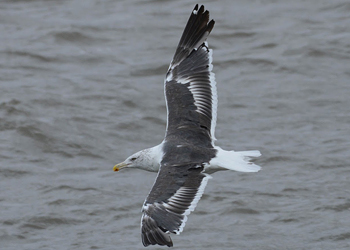 |
| Putative "Chandeleur" Gull smithsonianus X dominicanus adult, October 06 2013, Michigan City, IN. (Amar Ayyash). Note late moult. |
Putative "Chandeleur" Gull smithsonianus X dominicanus adult, November 20 2016, Michigan City, IN. (Amar Ayyash). Note late moult in this hybrid combo. |
Hybrid American Herring Gull X Great Black-backed Gull intermediate in size and structure between the parent species, with pale slaty upperparts and pinkish legs that could overlap Western Gull; orbital ring varies from yellow to red. Basic head streaking liner and perhaps more extensive in midwinter than Western, and wingtip averages more white: P10 has a large white mirror or white tip, P9 typically has a small white mirror, and there are white tongue-tips out to P7 or P8.
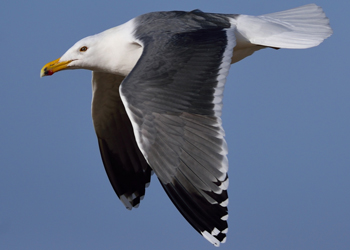 |
 |
| Putative "Great Lakes" Gull smithsonianus X marinus adult, March 05 2016, South, Race Point, Provincetown, Barnstable Co., MA. (Steve Arena). Great Black-backed Gull in many respects, but at the same time way too pale. With hefty bill, speckled iris, large mirror on P10. |
Putative "Great Lakes" Gull smithsonianus X marinus adult, March 05 2016, Cape May Point S.P., Cape May Co., NJ. (Tony Leukering. Showing large size (larger than the majority of GBBG present!), nearly perfectly intermediate mantle color, intermediate wingtip pattern. |
 |
 |
| Putative "Great Lakes" Gull smithsonianus X marinus adult, February 13 2016, Cleveland, Ohio (Chuck Slusarczyk Jr). Note upperpart grey tone. |
Putative "Great Lakes" Gull smithsonianus X marinus adult, February 27 2016, Lorain harbour, Ohio (Chuck Slusarczyk Jr). Note hefty bill, and mirror on P9. |
First Cycle.
Note overall size and structure, bill size and shape, overall dark brown aspect. See Great Black-backed Gull, Kelp Gull, Vega Gull, European Herring Gull, and Yellow-legged Gull for comparison. Also see hybrid Glaucous-winged Gull X Western Gull account.
Hybrid American Herring Gull X Great Black-backed Gull undescribed at this age but presumably intermediate in size and structure between the parent species; upperwings likely to be paler on inner primaries than Western, and tail less extensively blackish.
Hybrid Kelp Gull X American Herring Gull poorly known but likely to differ in structure; plumage of F1 similar to Kelp Gull.
Second Cycle.
Note overall size and structure, bill size and shape, pink legs, incoming slaty gray on upperparts. See Great Black-backed Gull, Kelp Gull, Vega Gull, European Herring Gull, and Yellow-legged Gull for comparison. Also see hybrid Glaucous-winged Gull X Western Gull account.
Hybrid American Herring Gull X Great Black-backed Gull undescribed at this age but presumably intermediate in size and structure between the parent species; upperwings likely to be paler on inner primaries than Western, and tail less extensively blackish.
Hybrid Kelp Gull X American Herring Gull likely to differ in structure; plumage similar to Lesser Black-backed Gull.
Third Cycle.
Differences much as adult cycle (which see).
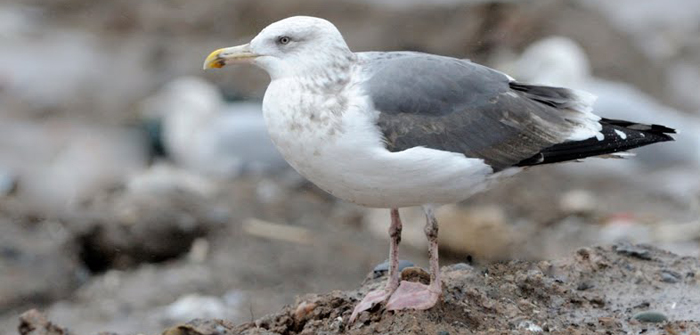
Habitat and behavior
Coastal, favoring fishing harbors, beaches, river mouths, etc. Ranges inland a short distance to dumps, reservoirs, freshwater lakes, also over inshore waters, mainly within 50 km of shore. Nests on rocky islands and islets, coastal cliffs, harbor markers, and even houses. Nonbreeding birds often in flocks (locally to a few thousand birds), associating readily with other gulls and water birds. Feeds commonly by scavenging; also forages in intertidal and surface waters for marine invertebrates and preys on eggs and young birds, also on small adult seabirds at colonies (such as storm-petrels and auklets). Western and Glaucous-winged Gulls and their hybrids dominate coastal feeding sites, which helps explain why Herring Culls do not winter commonly along the immediate coast in the range of Western Gulls.
Description & molt
L. o. occidentalis (n. California and north).
Adult Cycle.
Complete PB molt (mid-May/early July-Nov./Dec.) produces adult basic plumage: head, neck, and underparts white; head and neck with variable (usually slight) dusky clouding and streaking in fresh plumage. This dusky often wears away by early winter and is heaviest in northern birds (reflecting introgression with Glaucous-winged Gull?). Upperparts slaty gray (Kodak 8-9.5) with black wingtips (black on outer webs of P8-P10, sometimes P7-P10, extends to primary coverts), bold white scapular and tertial crescents, and white tips to outer primaries.
Uppertail coverts and tail white. White trailing edge to secondaries (often shows as a skirt) and inner primaries breaks into discrete white tips on outer primaries; P5-P6 typically have narrow white tongue-tips, and P10 a white mirror; up to 5 percent or so of adults also have a small white P9 mirror (Howell pers. obs.). Underwings show blackish wingtips (with white primary tips and mirrors) blending into white-tipped, dusky gray inner primaries and secondaries, which form a dusky subterminal band on underwings. Eyes lemon whitish to dull olive, orbital ring chrome yellow. Bill bright yellow to orange-yellow with reddish gonydeal spot and sometimes a small dusky mark at gonys; often suffused pinkish at base and with dark distal marks during height of PB molt; returns to bright yellow by early winter. Legs flesh pink, often paler during height of PB molt. Partial PA molt (Oct.-Feb.) produces adult alternate plumage: head and neck clean white (often by Dec./Jan.). By spring, orbital ring, bill, and legs brighter, bill lacks dark distal marks; white primary tips can be lost through wear. Legs of some birds (mainly Feb.-Apr.) become salmon-yellow although typically with pinkish joints and foot webbing (Howell pers. obs.).
First Cycle.
Juvenile ( late July-Nov.): dark sooty brown overall, less often gray-brown and exceptionally very dark, blackish brown. Head, neck, and underparts variably mottled and streaked whitish, becoming white on vent and undertail coverts, which have fairly heavy dark barring; some birds have belly mostly veiled whitish, contrasting sharply with brown chest and flanks. Upperparts with buff (bleaching to whitish) scaly and notched edgings and markings, the greater coverts typically with unmarked (or lightly marked) bases.
Tertials blackish brown with notched whitish tips and distal edging, the dark tertial bases merging with dark secondary bases that often show as a skirt. Uppertail coverts whitish with dark barring. Flight feathers blackish, secondaries and tail narrowly tipped whitish, tail with whitish bars at basal corners and often with white ribbing on outer web of R6.
IN FLIGHT: dark brown overall (some with contrastingly whitish belly) with whitish uppertail coverts, blackish tail, blackish remiges with narrow white trailing edge to secondaries and poorly contrasting browner panel on inner primaries, and plain brown greater-covert bases; underwings dark but reflective underside of primaries can look silvery. Eyes dark, bill blackish and often with some dull pinkish basally, legs dusky flesh to flesh pink.
PA1 molt (Sept./Nov.-Apr./May; exceptionally includes upperwing coverts) produces first alternate plumage: head, neck, chest, and flanks variably mixed sooty brown to gray-brown (new feathers) and paler brown to gingery brown (bleached juvenal feathers), the nape sometimes bleaching to whitish. By spring, some (early-molting?) birds have head, neck, and chest bleached dirty whitish; others at this season (late-molting or starting PB2?) are dark sooty overall. Back mottled dark brownish to sooty gray with pale edgings, the new scapulars ranging from dark sooty brown with blackish shaft streaks and broad pale buff edges (earlier-molted feathers) to dark slaty with blacker shalt streaks and indistinct browner tips (some later-molted feathers). Blackish to brownish black wingtips contrast with worn brownish upperwing coverts (which can bleach to a whitish and pale brown panel), and outer primaries often show narrow bleached pale tips. Bill typically shows some dull-flesh to pinkish basally, sometimes a pale horn tip; legs flesh pink.
Second Cycle.
Complete PB2 molt (Apr./May-Sept./Oct.) into second basic plumage. “Brown type” has head, neck, and underparts mottled dusky brown overall with variable whitish streaking and mottling. Upperparts more uniform than first cycle: mixed dark brown and gray-brown overall, wing coverts in particular with paler tips and bars creating variably scaly to checkered appearance; bases of greater coverts usually solidly patterned and tertials blackish with broad, marbled whitish tips. Wingtips blackish with fine pale fringes that can bleach to whitish. White uppertail coverts have sparse dark marks and contrast with mostly blackish tail; outer rectrices with white basal corners more diffuse and averaging more extensive than first cycle. Upperwings variably gray-brown with blackish wingtips and fairly broad whitish trailing edge to blackish secondaries and brown inner primaries. Underwings dark overall. Eyes dark brown to pale grayish, bill averages more extensively pinkish at base and often has small pale horn tip (sometimes extensively flesh pink on basal two-thirds, with diffusely defined blackish tip), legs flesh pink. “Gray type” (up to 20 percent of birds) has head, neck, and underparts whiter overall, back grayer, and bill typically pinkish with blackish tip or broad distal band. Gray and brown types represent extremes of variability; intermediates common. Partial PA2 molt (mid-Aug./Sept.-Apr.; usually includes some upperwing coverts) produces second alternate plumage: head, neck, and underparts whitish with variable dusky mottling and streaking (bleaching and wearing to mostly white), back becomes mostly slaty gray in contrast to faded brownish upperwing coverts, some birds attain a few slaty gray upperwing coverts, especially median coverts. Eyes pale lemon to brown, orbital ring often yellowish in summer. Through winter, bill typically pinkish basally, blackish distally; in summer often becomes yellow with red gonydeal spot and black distal band - advanced birds have adult-like bill, whereas retarded birds retain blackish bill with limited pinkish basally. Legs flesh pink.
Third Cycle.
Complete PB3 molt (May-Oct.) produces third basic plumage: resembles adult basic overall but with more dusky clouding and streaking on head, neck, and sometimes on chest; browner upperwing coverts; narrower white tips to remiges and smaller to absent P10 mirror (and no P9 mirror); often some blackish on tertial centers, primary coverts, and tail (which varies from all white to extensively black). Birds of this age more often look relatively dark slaty above than other ages (and suggest southern wymani), possibly due to the darkening effect of brown pigment in a slaty gray ground color. Underwings like adult but with some dusky on coverts. Bare parts like adult except bill regresses from yellow of second cycle to mostly pinkish and black during end of PB3 molt, often pink to yellow with black subterminal ring in midwinter. Partial PA3 molt (Sept.-Mar.) into third alternate plumage: dark markings on head and neck reduced to absent; bill brightens by summer and often indistinguishable from adult, or with dark distal marks. White tips to outer primaries often lost by wear. Adult plumage attained by complete PB4 molt (mid-May/June-Oct./Nov.).
L. o. wymani (s. California and south).
Molts average 1-2 weeks earlier than L. o. occidentalis but much overlap (and interannual variation).
Adult Cycle.
Plumages similar to nominate occidentalis but upperparts slightly darker slaty gray (Kodak 9.5-11); less contrasting black wingtips have reduced whitish tongue-tips and rarely show subterminal black on P4. Most adults cleanly white headed by November. Eyes lemon whitish to dull olive, similar to occidentalis.
Based on comparison of nominate occidentalis in n. cen. California and wymani in Baja
California (Howell pers. obs.) several average differences occur in plumage and bare-part progression of immatures, with wymani overall more advanced in appearance (but molt timing similar). Thus first-winter wymani in some respects (such as bill color, whiter head and underparts) looks as much like Yellow-footed Gull as it does northern Western Gull.
First Cycle.
Juvenile: No consistent differences noted. First alternate plumage averages more gray on upperparts, whiter head, neck, and underparts, and bill more often with extensive pink on basal two-thirds from first winter onward; on up to 10 percent of birds, PA1 molt can include a few to many upperwing coverts and some tertials (Howell pers. obs.).
Second Cycle.
In second basic plumage up to 80 percent of birds are “gray types” (versus up to 20 percent in occidentalis). Proportions of bill patterns appear “reversed” between immature wymani and occidentalis. Thus 75 percent of second-cycle wymani in Sept.-Oct. (n = 100) have flesh pink bill with blackish distal third and fine pale tip, while only 20 percent of occidentalis at the same season have this pattern. Conversely, 70 percent of second-cycle occidentalis in Sept.-Oct. (n = 100) have mostly black bill with limited pinkish at the base, versus only 10 percent of wymani.
Third Cycle.
In third basic plumage, appearance averages more advanced than occidentalis with more fully slate gray upperparts and upperwings (less admixed with brown), tail more often all white. But up to 90 percent of third-cycle wymani in Sept.-Oct. (n = 50) have more “immature-like” chalky pink bill with black subterminal band or tip, and only 10 percent have yellowish bill with dark subterminal ring and orange-red gonydeal spot, this latter nattern tvpical of 50 percent of third-cycle occidentalis at this season (n = 50).
Hybrids
Interbreeds extensively with Glaucous-winged Gull (see Bell 1997; Hoffman et al. 1978 and Scott 1971), see hybrid account (below).
continue >>> part 4 - Glaucous-winged Gull X Western Gull |
occidentalis Western Gull |
 Western Gull occidentalis ...2406-20984 4th cycle (5CY), April 27 2016, Eureka, Humboldt Co., CA. Picture: EF.
Western Gull occidentalis ...2406-20984 4th cycle (5CY), April 27 2016, Eureka, Humboldt Co., CA. Picture: EF. Western Gull occidentalis adult, April 24 2017, Moss Landing, California, USA. Picture: John Cant.
Western Gull occidentalis adult, April 24 2017, Moss Landing, California, USA. Picture: John Cant. Western Gull occidentalis adult, April 26 2017, Monterey, California, USA. Picture: John Cant.
Western Gull occidentalis adult, April 26 2017, Monterey, California, USA. Picture: John Cant. Western Gull occidentalis adult, April 25 2017, Pacific Grove, California, USA. Picture: John Cant.
Western Gull occidentalis adult, April 25 2017, Pacific Grove, California, USA. Picture: John Cant. Western Gull occidentalis adult, April 24 2017, Pacific Grove, California, USA. Picture: John Cant.
Western Gull occidentalis adult, April 24 2017, Pacific Grove, California, USA. Picture: John Cant. Western Gull occidentalis adult, April 24 2017, Pacific Grove, California, USA. Picture: John Cant.
Western Gull occidentalis adult, April 24 2017, Pacific Grove, California, USA. Picture: John Cant. Western Gull occidentalis adult, April 24 2017, Pacific Grove, California, USA. Picture: John Cant.
Western Gull occidentalis adult, April 24 2017, Pacific Grove, California, USA. Picture: John Cant. Western Gull occidentalis adult, April 26 2017, Monterey, California, USA. Picture: John Cant.
Western Gull occidentalis adult, April 26 2017, Monterey, California, USA. Picture: John Cant. Western Gull occidentalis adult, April 24 2017, Pacific Grove, California, USA. Picture: John Cant.
Western Gull occidentalis adult, April 24 2017, Pacific Grove, California, USA. Picture: John Cant.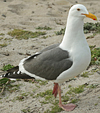 Western Gull occidentalis adult, April 24 2017, Pacific Grove, California, USA. Picture: John Cant.
Western Gull occidentalis adult, April 24 2017, Pacific Grove, California, USA. Picture: John Cant. Western Gull occidentalis adult, April 24 2017, Pacific Grove, California, USA. Picture: John Cant.
Western Gull occidentalis adult, April 24 2017, Pacific Grove, California, USA. Picture: John Cant. Western Gull occidentalis adult, April 26 2017, Monterey, California, USA. Picture: John Cant.
Western Gull occidentalis adult, April 26 2017, Monterey, California, USA. Picture: John Cant. Western Gull occidentalis adult, April 24 2017, Moss Landing, California, USA. Picture: John Cant.
Western Gull occidentalis adult, April 24 2017, Moss Landing, California, USA. Picture: John Cant. Western Gull occidentalis adult, April 24 2017, Moss Landing, California, USA. Picture: John Cant.
Western Gull occidentalis adult, April 24 2017, Moss Landing, California, USA. Picture: John Cant.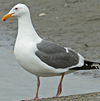 Western Gull occidentalis adult, April 24 2017, Moss Landing, California, USA. Picture: John Cant.
Western Gull occidentalis adult, April 24 2017, Moss Landing, California, USA. Picture: John Cant.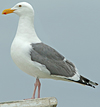 Western Gull occidentalis adult, April 24 2017, Moss Landing, California, USA. Picture: John Cant.
Western Gull occidentalis adult, April 24 2017, Moss Landing, California, USA. Picture: John Cant. Western Gull occidentalis adult, April 24 2017, Moss Landing, California, USA. Picture: John Cant.
Western Gull occidentalis adult, April 24 2017, Moss Landing, California, USA. Picture: John Cant.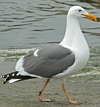 Western Gull occidentalis adult, April 24 2017, Moss Landing, California, USA. Picture: John Cant.
Western Gull occidentalis adult, April 24 2017, Moss Landing, California, USA. Picture: John Cant.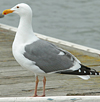 Western Gull occidentalis adult, April 24 2017, Moss Landing, California, USA. Picture: John Cant.
Western Gull occidentalis adult, April 24 2017, Moss Landing, California, USA. Picture: John Cant. Western Gull occidentalis adult, April 24 2017, Moss Landing, California, USA. Picture: John Cant.
Western Gull occidentalis adult, April 24 2017, Moss Landing, California, USA. Picture: John Cant. Western Gull occidentalis
Western Gull occidentalis




